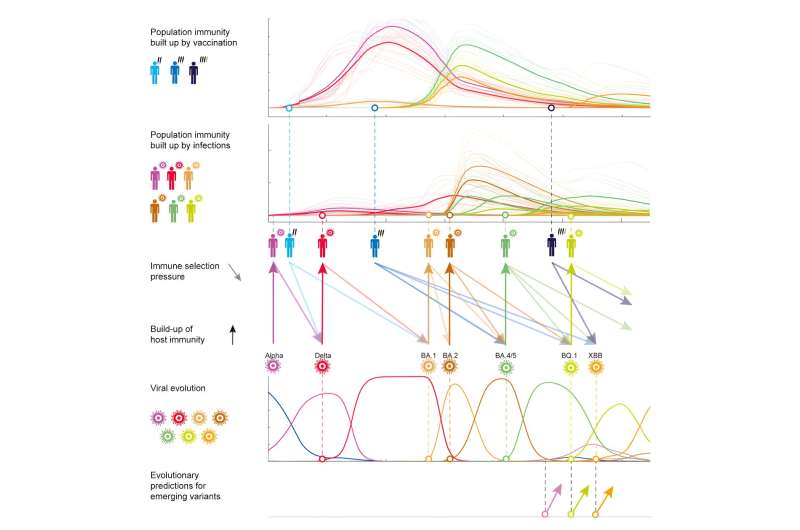This article has been reviewed according to Science X's editorial process and policies. Editors have highlighted the following attributes while ensuring the content's credibility:
fact-checked
peer-reviewed publication
trusted source
proofread
Model can predict the evolution of new COVID variants

An international research team from the University of Cologne and the Icahn School of Medicine, Mount Sinai (New York) has developed a model that predicts the likely evolution of variants of the SARS-CoV-2 virus.
First, the model predicts which variants can escape human immunity, spread through the population and eventually become new major variants. Second, it identifies likely pathways of escape evolution even before new variants actually emerge. The study, titled "Population immunity predicts evolutionary trajectories of SARS-CoV-2," has been published in the journal Cell.
During the SARS-CoV-2 pandemic, a new majority variant replaced the previous one in successive epidemic waves. By now, the evolution of the virus has become more complicated: Several variants are globally circulating at the same time and compete with each other. This is where predictive models become important to identify those variants that will likely rise to predominance in the near future.
On the one hand, new variants have intrinsic changes that can increase transmissibility. On the other hand, previous infections or vaccinations have generated immunity to older variants. The new model uses these factors to calculate fitness differences between variants. The analysis is based on massive, internationally collected experimental data, sequence data, and case numbers of infections and vaccinations.
The study shows that human immunity has now become the main driving force of the evolution of SARS-CoV-2. "This means that even after the pandemic is over, the virus will continue to produce new variants, and we need timely data on them. Our results show how important continued, internationally coordinated surveillance of the SARS-CoV-2 virus is," said Professor Dr. Michael Lässig from the Cologne Institute for Biological Physics and leader of the study.
"Predictions of viral evolution obtained from these data can help to design vaccines that are optimally effective against future variants." Lässig's lab has been working on predictive analysis of the flu virus for years and advises the World Health Organization on the selection of influenza vaccines.
The study was carried out at the Center for Predictive Analysis of Viral Evolution (Previr), an international, interdisciplinary research center based at the University of Cologne. Research at Previr focuses on a better understanding of viral evolution for public health.
More information: Matthijs Meijers et al, Population immunity predicts evolutionary trajectories of SARS-CoV-2, Cell (2023). DOI: 10.1016/j.cell.2023.09.022
Journal information: Cell
Provided by University of Cologne





















